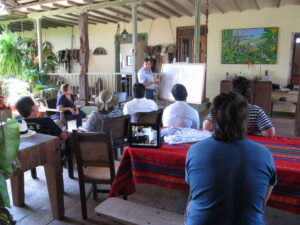
Click Here to Subscribe
Is there a way to feed millions and support economies without the severe environmental footprint left behind by conventional agricultural practices? There is! Regenerative agriculture is a growing movement and it includes practices such as agroforestry and silvopastoral systems- basically, food that’s grown and animals raised in a more forest-like setting. These methods help to regenerate topsoil, increase biodiversity, sequester carbon, and protect water supplies while actually increasing yields! Sounds too good to be true? Irene Montes’s father, Olimpo, made the switch to regenerative agriculture on his farm in Alcalá, Colombia, and was able to revive his dying land. In this episode, Irene shares her father’s story and how Pinzacuá Ranch has become a leading example in the region of how to farm more humanely and in-tune with the natural ecosystem.
Highlights From This Episode:
(2:19) What is conventional cattle ranching like in Latin America?
(6:50) Why did Irene’s dad decide to change his farming methods?
(10:00) What was the land like after chemical inputs were taken away?
(11:34) What effect do trees have when planted in this landscape?
(14:05) What ecosystem services returned?
(27:08) Are farmers in temperate zones having the same issues?
(32:38) What can the listener do?
How YOU can support regenerative agriculture practices:
- Produce delivery subscription services are increasing in popularity and allow for you to know where your food is coming from and how it’s grown. A quick Google search should help you to find subscription services by you.
- Try to buy more locally produced food. The best way to do that? Shop at your local farmers’ market.
- Look for products that have been certified by the Rainforest Alliance
- Grass-fed beef has a lighter eco-footprint and tends to be more humane than mass-produced beef from factory farms.
How YOU can bring back ecosystem services to your land (or balcony!):
- Here’s a great article on practical ways to increase biodiversity in your garden.
- Don’t call animal control if you see an opossum in your yard! They may be scary-looking (though they are more scared of you) but their favorite food is ticks and so they help keep the tick population in your area (aka Lyme disease) under control.
- Plant flowers that support pollinators like bees, butterflies, hummingbirds, and bats. Three-quarters of all food crops need pollinators to reproduce.
Want to learn more about Pinzacuá Ranch and/or the classes they offer? Check out their website!
Want some more good news? More than 2000 U.S. farmers sign a letter in support of climate action and it’s being sent to Capitol Hill! Click here to read the article.
Background music by Fearless Motivation Instrumentals: Meaning of Life
All Photos Credit: Pinzacua.com
WANT FREE STUFF?
Sign up below and every month, as a member, you have a chance to win products that help you reduce your environmental footprint. Plus, you’ll receive the weekly newsletter with the podcast show notes and summarized action tips.









Recent Comments